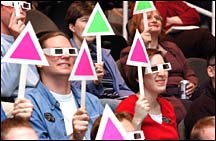|
|
|
|
|
October 10, 2003ISU a leader in blending real with digital
When a bulldozer driver excavates a building site, he's guided by a few stakes in the ground and a contour map. To pinpoint where to dig, he must reconcile the lines on the map with the stakes. The job might be considerably easier if the driver could don a pair of glasses that superimposes the contours of the map right on the ground. "Augmented reality" is the term for this blending of the real with the digital, and it's a key part of the fledgling field known as human computer interaction -- or HCI. New, innovative computer devices -- in the bulldozer driver's case, high-tech glasses -- are the trademark of HCI. They promise to so streamline interactions between people and computers that the mouse, the trackball, the keyboard will surely someday seem quaint and clunky. Those new, innovative devices are just the kind of thing they've been working on at Iowa State's Virtual Reality Applications Center over the past few years, and that's one of the reasons Iowa State has become a national leader in human computer interaction. In July, ISU became the second major research university in the nation (Carnegie Mellon was the first) to offer M.S. and Ph.D. degrees in the field. Ten students have enrolled in the program since then. "We are really good in HCI," said James Oliver, associate professor of mechanical engineering and a VRAC faculty affiliate. "That's what we discovered when we looked around." What they found when they looked around were pockets of scientists all over campus working on HCI-related research. The faculty came not only from "techie" fields like computer science and engineering, but psychology, journalism, math, statistics, music, geology, art, architecture, business, education, economics, agriculture, botany and religious studies. HCI aims to help people deal with all the computers (and computer-generated data) in their lives and that's a very interdisciplinary undertaking, Oliver said. "In all fields, we're inundated with data," Oliver said. "We don't suffer so much from information overload as attention overload. With all that data, how do we know what to look at?" A solution is to make better interfaces -- to develop devices that allow people to access data by seeing it, hearing it, touching it, who knows, maybe even tasting it. That solution requires a partnership between the technical experts, like computer scientists and engineers, and the subject matter experts, like historians, psychologists and musicians, Oliver said. "We put these people together and see what they can do." Buoyed by the local talent in the field, HCI was designated one of Iowa State's top academic initiatives in 2002. Subsequent funding brought three new human computer interaction experts to the Iowa State faculty this fall -- Chris Harding in the department of geological and atmospheric sciences, Chad Harms in the Greenlee School of Journalism and Communication, and Dirk Reiners in computer science.
|
|
Ames, Iowa 50011, (515) 294-4111 Published by: University Relations, online@iastate.edu Copyright © 1995-2003, Iowa State University. All rights reserved. |

